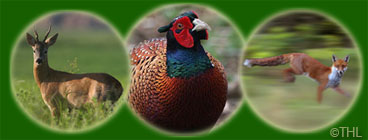Red Fox
What a beautiful and intelligent animal the red fox is. Although they are widespread across the UK the highest densities are to be found in and around our cities. The fox thrives around humans, our dirty habit of leaving refuse all around keeps the urban Charlie well fed. He finds warmth and security under our garden sheds, air vents and in our compost bins.
The fox thrives around humans, our dirty habit of leaving refuse all around keeps the urban Charlie well fed. He finds warmth and security under our garden sheds, air vents and in our compost bins.
Once December arrives the foxes find themselves awash with hormones. Frightful screams pierce the cold nights air as they begin their noisy courting. It is at this time of year that foxes can be seen mooching about in broad daylight totally oblivious to anything. The dog foxes are searching for scent to give clue as to the location of suitable mates.
Heavy vixens give birth to their cubs around March time, though this date does fluctuate, with some being born as early as January and others as late as April. The average litter size is four though I have heard of larger litters. From the age of five weeks old these little cubs can be seen venturing above ground in times of good weather. I watch them quite regularly during the early summer, finding the evenings the most productive with regards fox-watching. When the cubs are very young the vixen will not leave them for long. Food is brought to her by the dog fox and left outside the earth. Sometimes this smelly food is buried in a shallow scrape. The sheer variety of dead animals taken to the cubbing earth is quite amazing. Everything from voles to cats can be found in various stages of decomposition.
Once the cover gets up and summer starts to warm the countryside the cubs will leave their earth and spend the next five or six months living above ground learning how to hunt and generally how to survive. During this time foxes live in the cover of brambles and rush beds, often making a small “nest” in the grass to lay up in while they bask in the summer sunshine.
As the autumn wind cools the air, the fox, once again, becomes a viable quarry for the hunter. In the early part of the season the foxes will often be found deep in cover and can easily be bushed out with a couple of beaters or small dogs. Before the cover is beat the guys make sure they are in a good position with their lurchers or guns. This is a very effective way of catching foxes throughout the hunting season. Much has been written about fox killing lurchers, but there are no hard and fast rules in this, often painful, game. I have seen a wide array of lurcher types kill their fox and as long as the dog is strong enough for the task in hand then I don’t really think that breed matters at all.
The pursuit of foxes underground with the aid of terriers is another popular and effective method. There is no other legal way to catch those foxes that reside underground during daylight. Before the terrier is entered a locator collar is fitted to enable the terriers owner to find his dog underground and take a reading of how deep the earth is. This is important as he needs to know how big a hole to dig should the fox not bolt. All things being equal, for a four foot deep dig we make the pit four foot square. In many instances the fox will bolt out of the earth as the terrier barks at it. Such bolting foxes can either be shot with the shotgun, netted or ran with a lurcher. Either way should produce the goods. Which method of fox control a person uses is up to him. Each method has its uses in certain situations.
The red fox is a sporting and worthy quarry, please treat it with the respect that it deserves. Kill swiftly and ensure no suffering takes place.

